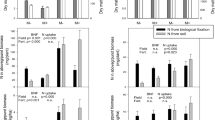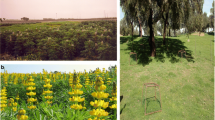Abstract
Aims
Biological nitrogen fixation by legumes is expected to play a greater role in future cropping systems. Our study evaluated 19 legume species grown as cover crops in Swiss agroecosystems.
Methods
Two field experiments were set up to monitor the biomass production and nitrogen content of 19 legumes and two non-legumes. The proportion of nitrogen derived from atmospheric N2 (%Ndfa) was assessed using the 15N natural abundance method. In parallel, a pot experiment was set up to determine the species-specific B values necessary to apply this method.
Results
Some species produced an important amount of biomass in 3 months, up to 6.86 t/ha for Vicia faba. Five species, Lathyrus sativus, Pisum sativum, Vicia sativa, Vicia villosa, and V. faba, acquired more than 100 kg/ha of N through biological fixation. Important amounts of nitrogen were also derived from the soil. %Ndfa values showed high variability between and within species, ranging from 0 % to almost 100 %.
Conclusions
Some legumes showed high N accumulation even in a short growing period, and could play an important role in fixing renewable nitrogen in crop rotation.


Similar content being viewed by others
References
Amarger N, Mariotti A, Mariotti F, Durr JC, Bourguignon C, Lagacherie B (1979) Estimate of symbiotically fixed nitrogen in field grown soybeans using variations in15N natural abundance. Plant Soil 52:269–280
Bergersen FJ, Turner GL (1983) An evaluation of 15N methods for estimating nitrogen fixation in a subterranean clover-perennial ryegrass sward. Aust J Agr Res 34:391–401
Boddey RM, Peoples MB, Palmer B, Dart PJ (2000) Use of the 15N natural abundance technique to quantify biological nitrogen fixation by woody perennials. Nutr Cycl Agroecosyst 57:235–270
Bohlool BB, Ladha JK, Garrity DP, George T (1992) Biological nitrogen fixation for sustainable agriculture: a perspective. Plant Soil 141:1–11
Brooks PD, Geilmann H, Werner RA, Brand WA (2003) Improved precision of coupled δ13C and δ15N measurements from single samples using an elemental analyzer/isotope ratio mass spectrometer combination with a post-column six-port valve and selective CO2 trapping; improved halide robustness of the combustion reactor using CeO2. Rapid Commun Mass Sp 17:1924–1926
Bues A, Preissel S, Reckling M, Zander P, Kuhlman T, Topp K, Watson C, Lindström K, Stoddard FL, Murphy-Bokern D (2013) The environmental role of protein crops in the new common agricultural policy. European Parliament, Directorate General For Internal Policies, policy department B: structural and cohesion policies, agricultural and rural development
Carranca C, de Varennes A, Rolston D (1999) Biological nitrogen fixation by fababean, pea and chickpea, under field conditions, estimated by the 15N isotope dilution technique. Eur J Agron 10:49–56
Dahlin AS, Stenberg M (2010) Transfer of N from red clover to perennial ryegrass in mixed stands under different cutting strategies. Eur J Agron 33(3):149–156
Ecoinvent Centre (2014) Ecoinvent data—the life cycle inventory data V3.1. Swiss centre for life cycle inventories, Dübendorf, ISBN 3-905594-38-2. Available at http://www.ecoinvent.org
FAL, RAC, FAW (2004) Méthodes de référence des stations fédérales de recherches agronomiques. Agroscope, vol. 2, Zurich-Reckenholz
Frankow-Lindberg BE, Dahlin AS (2013) N2 fixation, N transfer, and yield in grassland communities including a deep-rooted legume or non-legume species. Plant Soil 370:567–581
Fustec J, Lesuffleur F, Mahieu S, Cliquet JB (2010) Nitrogen rhizodeposition of legumes. A review. Agron Sustain Dev 30:57–66
Gallet A, Flisch R, Ryser JP, Nösberger J, Frossard E, Sinaj S (2003) Uptake of residual phosphate and freshly applied diammonium phosphate by Lolium perenne and Trifolium repens. J Plant Nutr Soil Sci 166:557–567
Gehring C, Vlek PLG (2004) Limitations of the 15N natural abundance method for estimating biological nitrogen fixation in Amazonian forest legumes. Basic Appl Ecol 5:567–580
GL-Pro (2005) Guidelines for growing grain legumes in Europe. GL-Pro concerted Action, p. 8
Hauggaard-Nielsen H, Gooding M, Ambus P, Corre-Hellou G, Crozat Y, Dahlmann C, Dibet A, Von Fragstein P, Pristeri A, Monti M (2009) Pea–barley intercropping for efficient symbiotic N2-fixation, soil N acquisition and use of other nutrients in European organic cropping systems. Field Crops Res 113:64–71
Hellsten A, Huss-Danell K (2000) Interaction effects of nitrogen and phosphorus on nodulation in red clover (Trifolium pratense L.). Acta Agr Scand B-S P 50:135–142
Hofstra N, Bouwman AF (2005) Denitrification in agricultural soils: summarizing published data and estimating global annual rates. Nutr Cycl Agroecosys 72:267–278
Högberg P (1997) 15N natural abundance in soil–plant systems: Tansley review No. 95. New Phytol 137:179–203
Høgh-Jensen H, Schjoerring JK (1994) Measurement of biological dinitrogen fixation in grassland: comparison of the enriched 15N dilution and the 15N abundance methods at different nitrogen application rates and defoliation frequencies. Plant Soil 166:153–163
Jensen ES (1996a) Grain yield, symbiotic N2 fixation and interspecific competition for inorganic N in pea-barley intercrops. Plant Soil 182:25–38
Jensen ES (1996b) Compared cycling in a soil-plant system of pea and barley residue nitrogen. Plant Soil 182:13–23
Jensen ES (1996c) Nitrogen and grain legumes: advantages and problems to balance. Grain Legumes 14:22
Jensen ES, Peoples MB, Boddey RM, Gresshoff PM, Hauggaard-Nielsen H, Alves BJR, Morrison MJ (2012) Legumes for mitigation of climate change and the provision of feedstock for biofuels and biorefineries. A review. Agron Sustain Dev 32:329–364
Justes E, Mary B, Nicolardot B (2009) Quantifying and modelling C and N mineralization kinetics of catch crop residues in soil: parameterization of the residue decomposition module of STICS model for mature and non mature residues. Plant Soil 325:171–185
Justes E, Beaudoin N, Bertuzzi P, Charles R, Constantin J, Dürr C, Hermon C, Joannon A, Le Bas C, Mary B, Mignolet C, Montfort F, Ruiz L, Sarthou JP, Souchère V, Tournebize J, Savini I, Réchauchère O (2012) The use of cover crops to reduce nitrate leaching: effect on the water and nitrogen balance and other ecosystem services. Synopsis of the study report. INRA, France
Kohl DH, Shearer G (1980) Isotopic fractionation associated with symbiotic N2 fixation and uptake of NO3 − by plants. Plant Physiol 66:51–56
Ledgard SF (1989) Nutrition, moisture and rhizobial strain influence isotopic fractionation during N2 fixation in pasture legumes. Soil Biol Biochem 21:65–68
López-Bellido L, López-Bellido RJ, Redondo R, Benítez J (2006) Faba bean nitrogen fixation in a wheat-based rotation under rainfed Mediterranean conditions: effect of tillage system. Field Crops Res 98:253–260
Moyer-Henry KA, Burton JW, Israel DW, Rufty TW (2006) Nitrogen transfer between plants: a 15N natural abundance study with crop and weed species. Plant Soil 282:7–20
Nemecek T, von Richthofen JS, Dubois G, Casta P, Charles R, Pahl H (2008) Environmental impacts of introducing grain legumes into European crop rotations. Eur J Agron 28:380–393
Okito A, Alves BRJ, Urquiaga S, Boddey RM (2004) Isotopic fractionation during N2 fixation by four tropical legumes. Soil Biol Biochem 36:1179–1190
Pate JS, Unkovich MJ, Armstrong EL, Sanford P (1994) Selection of reference plants for 15N natural abundance assessment of N2 fixation by crop and pasture legumes in south-west Australia. Aust J Agric Res 45:133–147
Peoples MB, Turner GL, Shah Z, Aslam M, Ali S, Maskey S, Bhattari S, Afandi F, Schwenke G, Herridge D (1997) Evaluation of the 15N natural abundance technique for measuring N2 fixation in experimental plots and farmers’ fields. In: Rupella OP, Johansen C, Herridge DF (eds) Extending nitrogen fixation research to farmers fields. ICRISAT, Patancheru, pp 57–75
Peoples MB, Boddey RM, Herridge DF (2002) Quantification of nitrogen fixation. In: Leigh GJ (ed) Nitrogen fixation at the millennium. Elsevier Science, Amsterdam, pp 357–389
Peoples MB, Brockwell J, Herridge DF, Rochester IJ, Alves BJR, Urquiaga S, Boddey RM, Dakora FD, Bhattarai S, Maskey SL, Sampet C, Rerkasem B, Khan DF, Hauggaard-Nielsen H, Jensen ES (2009) The contributions of nitrogen fixing crop legumes to the productivity of agricultural systems. Symbiosis 48:1–17
Pirhofer-Walzl K, Rasmussen J, Høgh-Jensen H, Eriksen J, Soegaard K, Rasmussen J (2012) Nitrogen transfer from forage legumes to nine neighbouring plants in a multi-species grassland. Plant Soil 350:71–84
R Core Team (2014) R: A language and environment for statistical computing. R Foundation for Statistical Computing, Vienna
Riffkin PA, Quigley P, Kearney G, Cameron F, Gault R, Peoples M, Thies J (1999) Factors associated with biological nitrogen fixation in dairy pastures in south-western Victoria. Aust J Agric Res 50:261–272
Roscher C, Thein S, Weigelt A, Temperton V, Buchmann N, Schulze ED (2011) N2 fixation and performance of 12 legume species in a 6-year grassland biodiversity experiment. Plant Soil 341:333–348
Schipanski ME, Drinkwater LE (2012) Nitrogen fixation in annual and perennial legume–grass mixtures across a fertility gradient. Plant Soil 357:147–159
Shearer G, Kohl DH (1986) N2 fixation in field settings: estimates based on natural 15N abundance. Aust J Plant Physiol 13:699–756
Thorup-Kristensen K, Nielsen NE (1998) Modelling and measuring the effect of nitrogen catch crops on the nitrogen supply for succeeding crops. Plant Soil 203:79–89
Thorup-Kristensen K, Magid J, Jensen LS (2003) Catch crops and green manures as biological tools in nitrogen management in temperate zones. Adv Agron 79:227–302
Turner GL, Bergersen FJ (1983) Natural abundance of 15N in root nodules of soybean, lupin, subterranean clover and lucerne. Soil Biol Biochem 15:525–530
Unkovich MJ, Pate JS (2000) An appraisal of recent field measurements of symbiotic N2 fixation by annual legumes. Field Crops Res 65:211–228
Unkovich MJ, Pate JS, Armstrong EL (1994) Potential precision of the δ15N natural abundance method in field estimates of nitrogen fixation by crop and pasture legumes in South-West Australia. Aust J Agric Res 45:119–132
Unkovich MJ, Pate JS, Sanford P (1997) Nitrogen fixation by annual legumes in Australian Mediterranean agriculture. Aust J Agric Res 48:267–293
Unkovich M, Herridge D, Peoples M, Cadisch G, Boddey B, Giller K, Alves B, Chalk P (2008) Measuring plant associated nitrogen fixation in agricultural systems. Australian Centre for International Agricultural Research (ACIAR), Australian Government, Canberra
van Kessel C, Hartley C (2000) Agricultural management of grain legumes: has it led to an increase in nitrogen fixation? Field Crops Res 65:165–181
Werner RA, Brand WA (2001) Referencing strategies and techniques in stable isotope ratio analysis. Rapid Commun Mass Sp 15:501–519
Werner RA, Bruch BA, Brand WA (1999) ConFlo III—an interface for high precision δ13C and δ15N analysis with an extended dynamic range. Rapid Commun Mass Sp 13:1237–1241
Yoneyama T, Fujita K, Yoshida T, Matsumoto T, Kambayashi I, Yazaki J (1986) Variation in natural abundance of 15N among plant parts and in 15N/14N fractionation during N2 fixation in the legume–rhizobia symbiotic system. Plant Cell Physiol 27:791–799
Acknowledgments
The authors thank Astrid Oberson for her valuable comments, the BSc students from Zollikofen (B value experiment), and all the people who helped in the field and lab work. We also thank Annika Ackermann from the Grassland Sciences group (Prof. Nina Buchmann) at ETH Zurich for stable isotope ratio analyses. The authors are also grateful to Drs. Larry Siwajek and Bernard Jeangros for their respective contributions on the manuscript. This study was partly funded by the Federal Office for Agriculture and by the Swiss National Science Foundation in the framework of the National Research Program NRP 68 “Sustainable Use of Soil as a Resource,” grant 406840-143063.
Author information
Authors and Affiliations
Corresponding author
Additional information
Responsible Editor: Martin Weih.
Electronic supplementary material
Below is the link to the electronic supplementary material.
ESM 1
(PDF 102 kb)
Rights and permissions
About this article
Cite this article
Büchi, L., Gebhard, CA., Liebisch, F. et al. Accumulation of biologically fixed nitrogen by legumes cultivated as cover crops in Switzerland. Plant Soil 393, 163–175 (2015). https://doi.org/10.1007/s11104-015-2476-7
Received:
Accepted:
Published:
Issue Date:
DOI: https://doi.org/10.1007/s11104-015-2476-7




